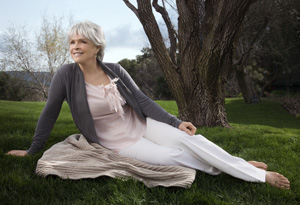Can These Four Questions Change Your Life?

Photo: Julian Dufort
In her darkest hour, Byron Katie—now a spiritual mentor to millions—discovered that life isn't half as painful as we make it. With the help of four simple questions, she shows Caitlin Flanagan how to stop suffering and start getting real.
In the summer of 2008, I was diagnosed with a metastatic recurrence of the breast cancer I thought I'd seen the last of five years earlier, when it had been a relatively laughable stage III. (In case you're not familiar with cancer staging, I'll quote Emma Thompson in Wit: "There is no stage V.") I heard the doctor say "liver," I heard the doctor say "lung," and both words sounded so much like death that for a while I couldn't hear anything else. When I went for chemo, I didn't bring photographs of my two young sons the way I had the first time through. I couldn't bear to look at their faces as I was failing them. It was a summer of darkness and dread.And then one day, for no discernible reason, it occurred to me that instead of continuing to sit in bed bald and weepy, maybe I should try to cheer up. It was such a crazy idea, I decided to go with it. Being at that moment of limited resources—a TV remote, a laptop, and a can of Ensure—what I did was patch myself through to Oprah.com.
I came across three videos of Oprah interviewing a 60-something woman with short white hair, extraordinary violet eyes, a mesmerizingly calm and benevolent manner, and the strange name Byron Katie. At the age of 43, Katie, as she is called, had had a life-changing realization about the importance of living in the reality of the present moment. All the suffering that goes on inside our minds, she told Oprah, is not reality. It's just a story we torture ourselves with.
The last thing a cancer patient with tumors in her liver wants to hear is that her suffering exists only in her mind. But Katie had something else to offer, too, or so she said: a simple, completely replicable system for getting rid of the thoughts that make us suffer. "All war belongs on paper," she told Oprah, and then she explained how to go to battle: You write down each and every stressful thought, and then ask yourself four questions about it.
Is it true?
Can I absolutely know it's true?
How do I react when I believe this thought?
Who would I be without the thought?
Afterward, when you have completely wrestled the thought to the ground, you replace it with a "turnaround"—an opposite thought, one that is "as true or truer" and that doesn't cause you suffering.
I grabbed my journal and got to work. Almost immediately I felt a shift; it was as though, at least for a few moments, my problems started to ease. Yes, it was true that I'd been diagnosed with stage IV cancer. On the other hand, if you pushed me—did I absolutely know I had cancer?—I had to admit I didn't. I was in the middle of chemotherapy, after all—for all I knew, it was working beautifully. The thought that I had cancer made me feel terrified and immobilized. Without that thought, I was free—I was just myself, sitting on my bed with the windows open, completely alive and enjoying the breeze.
I got pretty far that first day or two, asking the questions, following them up with a turnaround, and feeling better each time I did, but I had a hunch that I was going to get only so far on my own. There was something eating away at me that I couldn't even identify, let alone question. And this is when things got a little bit crazy, because after seeing how much I'd changed my mood by simply writing some questions and answers, it seemed that the next thing to do—the only thing to do—was sit down with Byron Katie and talk to her in person.
The morning in a Los Angeles halfway house that changed Byron Katie's life



